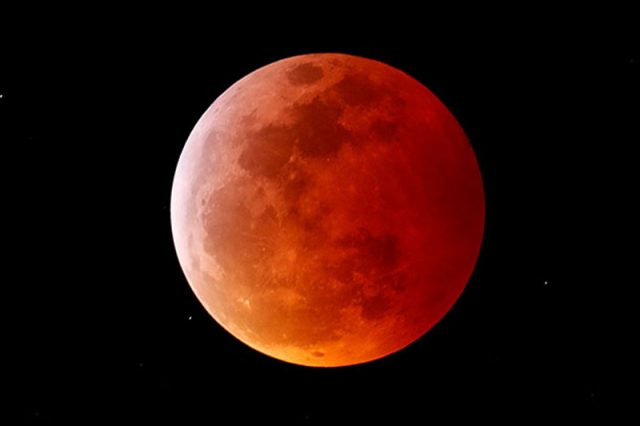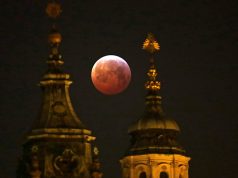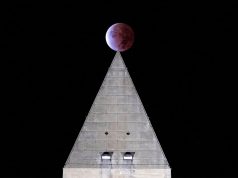
Selenophiles have a chance to witness the moon turning red this Tuesday as the celestial body undergoes a total lunar eclipse that won’t occur until 2025.
State meteorologists in an astronomical diary said that Filipinos will witness the phenomenon at 6:59 p.m. on November 8
A total lunar eclipse occurs when the sun, earth and moon align in a way that the entire moon falls into the darkest part of the earth’s shadow, called the “umbra.”
When the moon is within the umbra, it will emit a reddish color.
The US National Aeronautics and Space Administration attributes this to the Rayleigh scattering.
This refers to the scattering of light off of the molecules of the air. It can be extended to the scattering from particles up to about a tenth of the wavelength of the light.
The phenomenon is responsible for making the sky look blue and the sun, yellow.
“During a lunar eclipse, Earth’s atmosphere scatters sunlight. The blue light from the Sun scatters away, and longer-wavelength red, orange, and yellow light pass through, turning our Moon red,” NASA said on its website.
“When the Moon is within the umbra, it will turn a reddish hue. Lunar eclipses are sometimes called ‘Blood Moons’ because of this phenomenon,” it added.
Filipino state meteorologists said that the phenomenon’s predicted time of occurrence is the following:
- Penumbral eclipse begins — 4:00 p.m. (not visible)
- Partial eclipse begins — 5:08 p.m. (not visible)
- Moonrise in Manila — 5:19 p.m.
- Moon enters totality — 6:16 p.m.
- Maximum eclipse — 6:59 p.m.
- Moon exits totality — 7:42 p.m.
- Partial eclipse ends — 8:49 p.m.
- Penumbral eclipse ends — 9:57 p.m.
The Philippine Astronomical Society Inc said that the total lunar eclipse could be viewed in the following observation sites:
Quezon City
- Host: UP Astronomical Society
- Venue: PAGASA Astronomical Observatory
- Set up time: Starts at 6 p.m.
- Map: https://goo.gl/maps/j518tCELfhe49egz5
- Open to public
- More details here
Las Piñas City
- Host: Skywatchers Society of Las Pinas
- Venue: Robinsons Las Piñas – Level 2, Verandah Area
- Set up time: Starts at 6 p.m.
- Map: https://goo.gl/maps/ZZB17ah2cYuMJzqK7
- Open to public
- More details here
Taytay, Rizal
- Host: Dipper Co. and Manila Street Astronomers
- Venue: Kape-Hingahan Parking Grounds
- Set up time: 5 p.m. to 9 p.m.
- Map: https://goo.gl/maps/6nqFHhQTiGpFEqSk9
- Open to public
- More details here
Cavite City, Cavite
- Host: Cavite Sky Observers
- Venue: Unlad Park
- Set up time: Starts at 5 p.m.
- Map: https://goo.gl/maps/cBSCt76QKiWhc7y79
- Open to public
- More details here
Imus, Cavite
- Host: Cavite Sky Observers
- Venue: SM Center Imus
- Set up time: 5 p.m. to 9 p.m.
- Map: https://g.page/sm-center-imus-smim?share
- Open to public
- More details here
Noveleta, Cavite
- Host: Cavite Sky Observers
- Venue: Long Beach Resort
- Set up time: Starts at 5 p.m.
- Map: https://goo.gl/maps/qfmeWAMnwuuarj9s8
- Open to public
- More details here
San Pablo City, Laguna
- Host: 7 Lakes Astronomy
- Venue: Bonifacio Statue at Sampaloc Lake
- Set up time: Starts at 5:30 p.m.
- Map: https://goo.gl/maps/ghETKHmTgcWtjfMF8
- Open to public
- More details here
There will also be a showing in Manila through the Manila Observatory, but the society said there are no more slots left.
Those interested may still join them in Rizal Park or through their Facebook livestream which will be uploaded during the event.
NASA said that the next total lunar eclipse will occur on March 14, 2025, although people will continue to see partial and penumbral eclipses during that time.








